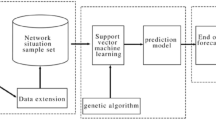Abstract
With the rapid development of the Internet of things (IoT) technology, how to effectively predict the network security situation of the IoT has become particularly important. It is difficult to quantify the IoT network situation due to a large number of historical data dimensions, and there are also has the problem of low accuracy for IoT network security situation prediction with multi-peak changes. To solve the above problems, this paper proposed an adaptive IoT network security situation prediction model, which makes the IoT network security situation prediction accuracy higher. Firstly, the paper used the entropy correlation method to calculate the network security situation value sequence in each quantization period according to Alarm Frequency (AF), Alarm Criticality (AC), and Alarm Severity (AS). Then, the security situation values arranged in time series are fragmented through the sliding window mechanism, and then the adaptive cubic exponential smoothing method is used to initially generate the IoT network security situation prediction results. Finally, the paper built the time-varying weighted Markov chain to predict the error value and modify the initial predicted value based on the error state. The experimental results show that the model has a better fitting effect and higher prediction accuracy than other models, and this model’s determination coefficient is 0.811. Compared with the other two models, the sum of squared errors in this model is reduced by 78 %-82 %. The model can better reflect the changes in the IoT network security situation over a while.





Similar content being viewed by others
Data Availability
The data set used in this study is Lincoln Laboratory’s standard dataset LL_ DOS_ 1.0.
Code Availability
Not applicable.
References
Tang C, WEI X LIUC et al (2020) UAV-enabled social internet of vehicles: roles, security issues and use case. In: 6th International Symposium on Security and Privacy in Social Networks and Big Data, pp 153–163
Olivier F, Carlos G, Florent N (2015) New security architecture for IoT network. Procedia Comput Sci 52:1028–1033
Leau YB, Manickam S (2015) Network security situation prediction: a review and discussion. information science and applications. Springer, Berlin
Zhang SB, Shen YJ, Zhang GD (2018) Network security situation prediction model based on multi-swarm chaotic particle optimization and optimized grey neural network. In: IEEE 9th International Conference on Software Engineering and Service Science, pp 426–429
Xiao P, Xian M, Wang HM (2017) Network security situation prediction method based on MEA-BP. In: 3rd International Conference on Computational Intelligence & Communication Technology, pp 1–5
Sun SX (2015) The research of the network security situation prediction mechanism based on the complex network. In: International Conference on Computational Intelligence and Communication Networks, pp 1183–1187
Zhou XW, Li XL (2018) Multi node network security situation prediction model based on improved G-K algorithm. Sci Technol Eng 18(25):72–77
Zhang RC, Liu YC, Liu J et al (2019) Network security situation prediction method using improved convolution neural network. Comput Eng Appl 55(6):86–93
Xi RR, Yun XC, Zhang YZ et al (2015) An improved quantitative evaluation method for network security. Chin J Comput 38(4):749–758
Debar H, Wespi A (2001) Aggregation and correlation of intrusion-detection alerts. In: International Symposium on Recent Advances in Intrusion Detection, Berlin, pp 85–103
Zhao DM, Zhang YQ, Ma JF (2004) Fuzzy risk assessment of entropy-weight coefficient method applied in network security. Comput Eng 30(18):21–23
Fu Y, Wu XP, Ye Q et al (2010) An approach for information systems security risk assessment on fuzzy set and entropy-weight. Acta Electron Sin 38(7):1489–1494
Huang S, Liu A, Zhang S, et al (2020) BD-VTE: a novel baseline data based verifiable trust evaluation scheme for smart network systems. IEEE Trans Netw Sci Eng. https://doi.org/10.1109/TNSE.2020.3014455
Jiang B, Huang G, Wang T et al (2020) Trust based Energy Efficient Data Collection With Unmanned Aerial Vehicle in Edge Network. Trans Emerg Telecommun Technol.. https://doi.org/10.1002/ett.3942
Wang X, Qi Y, Li QM (2017) Network anomaly detection model based on time-varying weighted Markov chain. Comput Sci 44(9):136-141 + 161
Li T, Liu W, Wang T et al (2020) Trust data collections via vehicles joint with unmanned aerial vehicles in the smart Internet of Things. Trans Emerg Telecommun Technol. https://doi.org/10.1002/ett.3956
Acknowledgements
This work was supported by the Civil Aviation Joint Research Fund Project of the National Natural Science Foundation of China under granted number U1833107. We are grateful for the support of this foundation project, as well as for the proofreading and valuable comments provided by all of our co-authors.
Funding
This work was supported by the Civil Aviation Joint Research Fund Project of the National Natural Science Foundation of China under granted number U1833107.
Author information
Authors and Affiliations
Contributions
Hongyu Yang proposed research ideas and methods. Le Zhang designed experiments, analyzed results and wrote the manuscript. Xugao Zhang conducted theoretical and methodological research. Jiyong Zhang gave suggestions for revision of this paper.
Corresponding author
Ethics declarations
Conflicts of Interest/Competing Interests
The authors declare that there is no conflict of interests regarding the publication of this paper.
Additional information
Publisher’s Note
Springer Nature remains neutral with regard to jurisdictional claims in published maps and institutional affiliations.
Rights and permissions
About this article
Cite this article
Yang, H., Zhang, L., Zhang, X. et al. An Adaptive IoT Network Security Situation Prediction Model. Mobile Netw Appl 27, 371–381 (2022). https://doi.org/10.1007/s11036-021-01837-y
Accepted:
Published:
Issue Date:
DOI: https://doi.org/10.1007/s11036-021-01837-y




